10 Eco Friendly Floor Covering Options for Your Flooring Business
Explore 10 eco friendly floor covering options that enhance sustainability and appeal to consumers.

Introduction
The flooring industry is experiencing a notable transformation as eco-conscious consumers increasingly seek sustainable options for their homes and businesses. This shift presents flooring professionals with a unique opportunity to enhance their offerings while promoting environmental responsibility. However, navigating the diverse materials and understanding their benefits can be daunting. What are the best eco-friendly flooring options that not only meet sustainability standards but also appeal to modern aesthetic preferences?
As the demand for eco-friendly floor coverings grows, it is essential for flooring business owners to stay informed about the latest innovations and trends in sustainable materials. By doing so, they can not only meet consumer expectations but also position themselves as leaders in the industry. This article will explore the most effective eco-friendly flooring solutions, providing insights that will empower professionals to make informed decisions.
Service Buddy: Streamline Your Eco-Friendly Flooring Business Operations
Service Buddy offers flooring companies an all-in-one platform that transforms quoting, job management, and client communication into a streamlined process. By centralizing these essential operations, industry professionals can focus on eco-friendly floor covering materials and practices, thereby eliminating the burden of managing multiple outdated tools. This efficient approach not only boosts productivity but also empowers businesses to cater to environmentally conscious clients, ultimately enhancing customer satisfaction and loyalty.
Moreover, the platform's Growth Marketplace features tailored add-ons that bolster eco-friendly initiatives, including marketing tools designed to promote eco-friendly floor covering and other sustainable choices. Flooring business owners looking to elevate their operations should consider integrating Service Buddy to not only streamline their processes but also align with the growing demand for eco-friendly floor covering in the industry.
Bamboo Flooring: Sustainable and Fast-Growing Option
Bamboo flooring stands out as one of the most sustainable flooring options available, capable of growing up to three feet in just 24 hours. This remarkable growth rate positions this plant as a highly renewable resource, significantly reducing the need for deforestation. Environmentalists promote this plant because of its natural resistance to pests and moisture, which improves its durability in various environments. Furthermore, the distinctive aesthetic of this plant, characterized by natural variations in color and grain, adds a stylish touch to any space and appeals to eco-conscious consumers seeking beauty alongside sustainability.
The natural surface market is gaining traction, with the organic material holding a 60% market share in eco-friendly options as of 2024, while the strand woven variety accounts for 55% of the market. Thriving companies in the industry, such as Moso International and Cali Bamboo, increasingly utilize this grass as a primary material, acknowledging its potential to satisfy the growing consumer demand for sustainable products. This shift is further backed by the anticipated growth of the bamboo-based market, expected to rise from USD 1.43 billion in 2024 to USD 2.02 billion by 2034.
However, it is important to recognize that bamboo-based surfaces face challenges, such as moisture sensitivity, which can restrict their use in specific environments. As the market for bamboo surfaces continues to grow, it reflects a broader trend towards eco-friendly floor covering that aligns with sustainable building materials and eco-conscious consumer values. Flooring business owners must consider these factors as they explore the potential of bamboo in their product offerings.
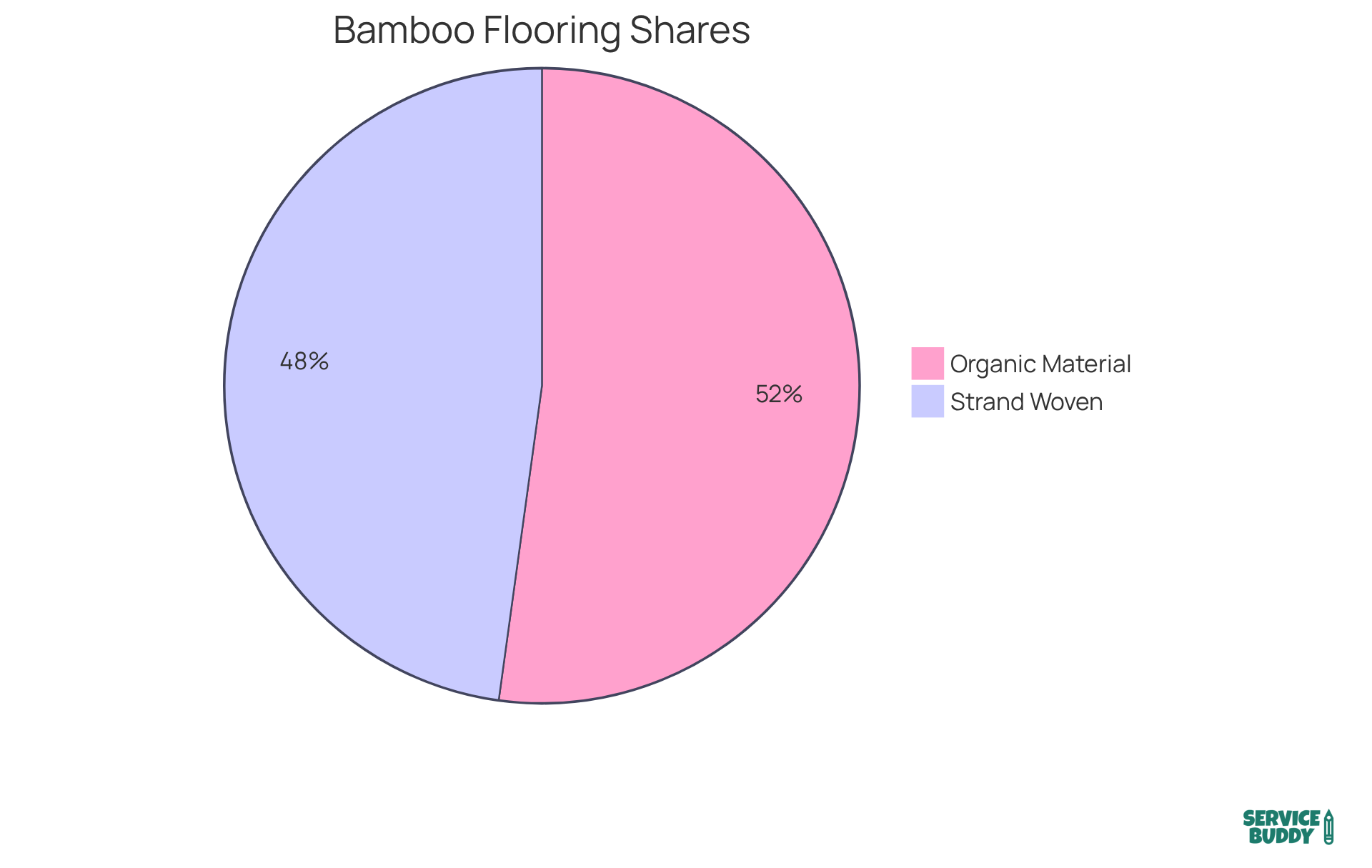
Cork Flooring: Comfortable and Renewable Material
Cork material, derived from the bark of cork oak trees, is a renewable resource due to the tree's ability to replenish after collection. This surfacing choice not only provides comfort underfoot but also delivers exceptional thermal and acoustic insulation. Furthermore, cork's natural resistance to mold and mildew makes it a healthy option for indoor environments. Its distinctive texture and appearance can significantly enhance the aesthetic of any room, making it an appealing choice for homeowners who prioritize both comfort and sustainability.
As flooring business owners, consider the advantages of incorporating cork into your offerings. This material not only meets the growing demand for eco friendly floor covering solutions but also addresses the comfort and health concerns of your clients. By positioning cork flooring as an eco friendly floor covering, you can differentiate your business in a competitive market and meet the needs of environmentally-conscious consumers.
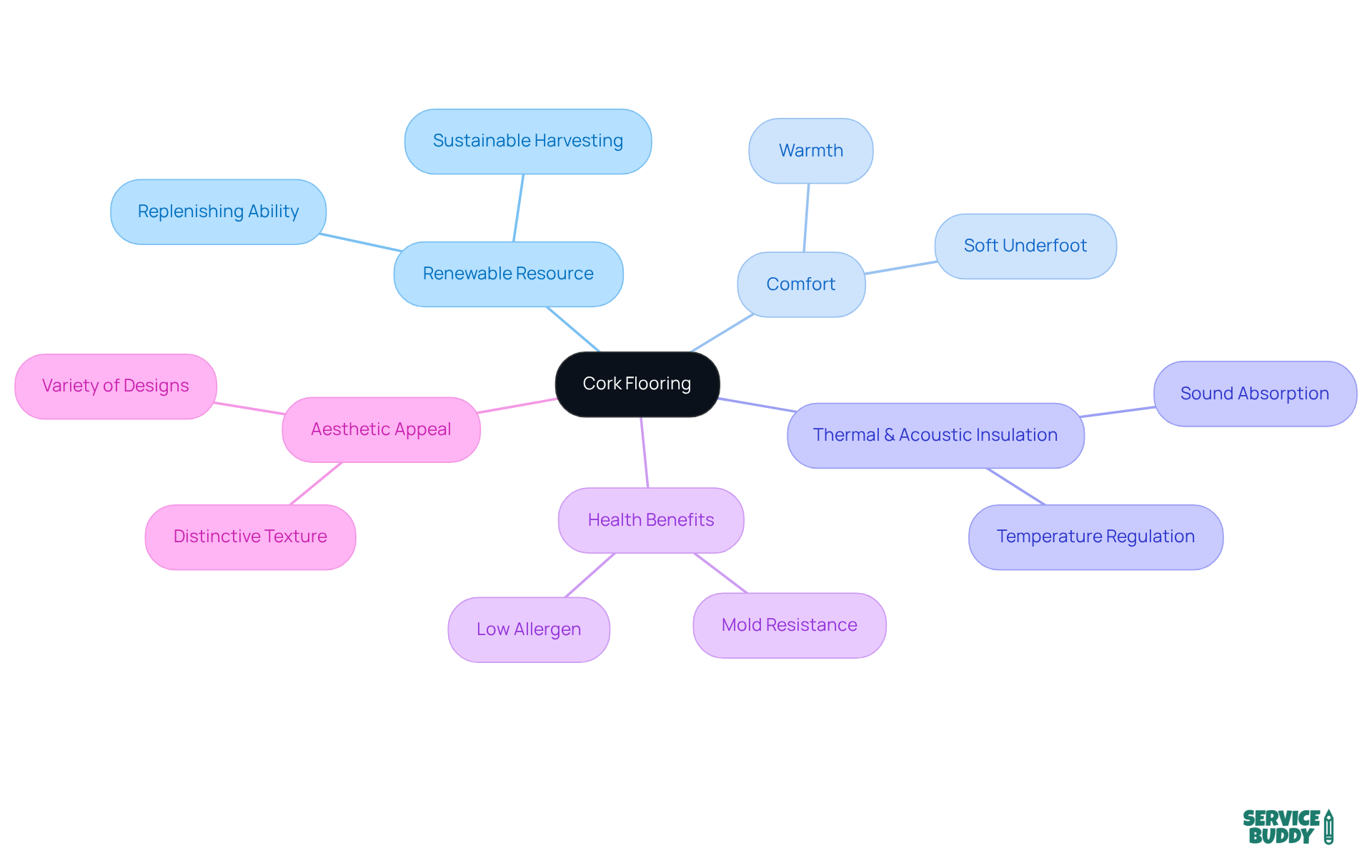
Reclaimed Hardwood Flooring: Eco-Friendly by Design
Reclaimed hardwood is sourced from old buildings, barns, and other structures, revitalizing wood that would otherwise be discarded. This eco friendly floor covering choice mitigates the demand for new lumber while infusing spaces with character and history. Each plank carries a unique story, showcasing imperfections and patinas that enhance its aesthetic appeal. Notably, reclaimed wood is an eco friendly floor covering that typically boasts a lower carbon footprint compared to newly harvested timber, making it a responsible option for environmentally conscious consumers.
Furthermore, the durability of reclaimed wood, often sourced from old-growth trees, ensures longevity and stability, reducing the likelihood of warping or cupping. Successful projects using reclaimed wood demonstrate its versatility, fitting seamlessly into both rustic and modern designs. Additionally, eco friendly floor covering made from reclaimed wood contributes to healthier indoor environments by being free from harmful chemicals commonly found in new wood products.
As sustainability advocates highlight, selecting reclaimed materials not only promotes eco-friendly floor covering but also nurtures a stronger connection to the history and craftsmanship of the wood. This results in a compelling option for any business in the flooring sector. Are you ready to embrace the benefits of reclaimed hardwood in your projects?
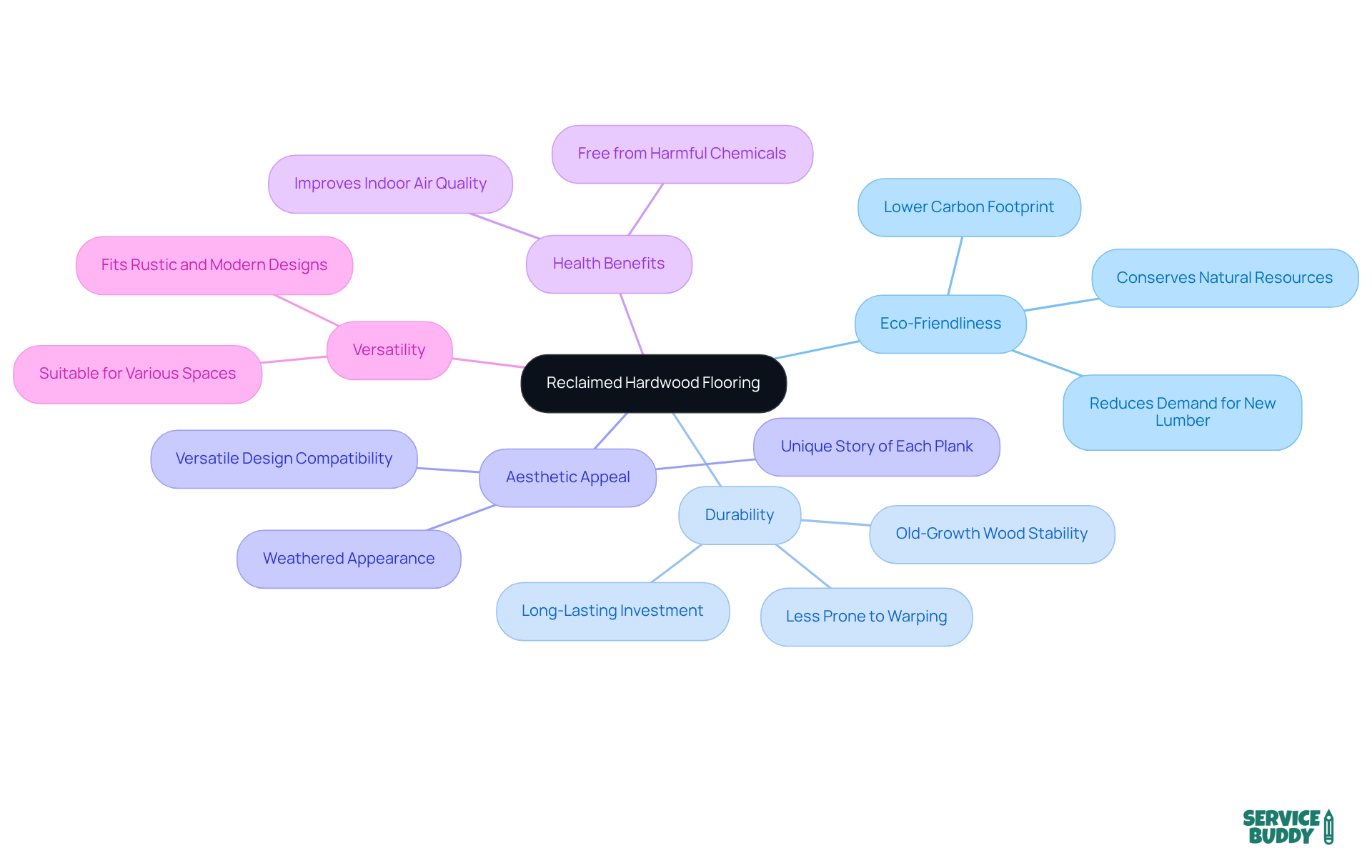
Linoleum Flooring: Natural and Biodegradable Choice
Linoleum surfaces, crafted from natural substances such as linseed oil, cork dust, and wood flour, present an eco-friendly flooring option. This biodegradable choice, as an eco friendly floor covering, is not only sustainable but also recognized for its exceptional durability, capable of lasting for decades with proper maintenance. Homeowners appreciate linoleum as an eco friendly floor covering due to its ease of upkeep and the extensive array of colors and patterns available, allowing for personalized and environmentally conscious design choices.
Moreover, the natural composition of linoleum as an eco friendly floor covering contributes to improved indoor air quality by emitting fewer volatile organic compounds (VOCs). This aspect is particularly crucial for flooring business owners who prioritize both sustainability and the health of their clients. By choosing linoleum, you are not just selecting an eco friendly floor covering; you are making a statement about your commitment to quality and the environment. Embrace the opportunity to enhance your offerings with an eco friendly floor covering that combines durability, aesthetic appeal, and ecological responsibility.
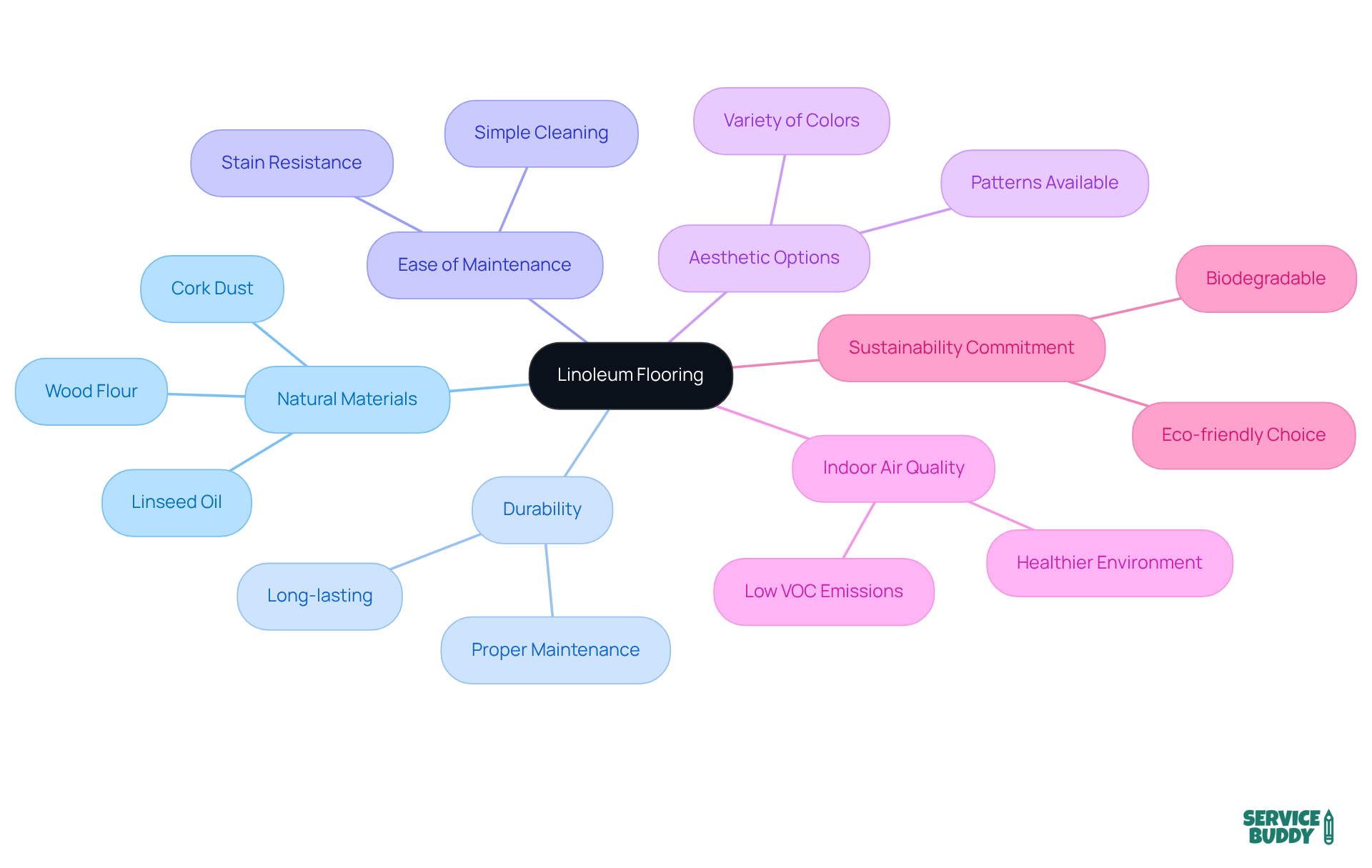
Concrete Flooring: Durable and Recyclable Material
Concrete surfaces represent one of the most durable choices available in the flooring industry, capable of lasting for decades with minimal upkeep. This material, which can be crafted into an eco friendly floor covering from recycled components like crushed concrete and industrial byproducts, significantly reduces the demand for virgin resources. Furthermore, concrete's ability to be polished or stained allows for a variety of aesthetic options, making it a versatile selection for both residential and commercial environments. Beyond its visual appeal, concrete's thermal mass properties contribute to regulating indoor temperatures, ultimately enhancing energy efficiency.
For flooring business owners facing operational challenges, considering concrete can be a strategic move. Its longevity, sustainability, and adaptability not only meet customer demands but also align with modern environmental standards for eco friendly floor covering. Embracing concrete surfaces could be the key to elevating your business offerings and ensuring client satisfaction.

Natural Stone Flooring: Timeless and Low-Maintenance
Natural stone surfaces, including slate, granite, and limestone, are celebrated for their exceptional durability and timeless beauty. Extracted from the earth with minimal processing, these materials are an eco friendly floor covering option for discerning homeowners. With their low-maintenance nature, natural stone can endure for generations, significantly reducing the need for frequent replacements.
The unique patterns and colors of natural stone make it an excellent eco friendly floor covering that enhances the aesthetic appeal of any space while resonating with those who prioritize both style and sustainability. Furthermore, using eco friendly floor covering like natural stone surfaces does not emit harmful chemicals, thereby contributing to healthier indoor air quality.
In a market where quality and environmental considerations are paramount, embracing natural stone could be the key to elevating your flooring offerings. Consider the long-term benefits and aesthetic advantages that eco friendly floor coverings provide, positioning your business as a leader in sustainable flooring solutions.

Engineered Hardwood Flooring: Cost-Effective and Eco-Friendly
Engineered hardwood surfaces are expertly constructed from layers of wood, featuring a top layer of genuine hardwood and a core made of plywood or high-density fiberboard. This innovative construction technique utilizes significantly less hardwood than solid wood surfaces, making it an eco friendly floor covering choice for environmentally-conscious consumers.
Moreover, engineered hardwood is less susceptible to moisture and temperature changes, rendering it suitable for a variety of environments. It delivers the same aesthetic appeal as solid hardwood while being more cost-effective, thus appealing to budget-conscious flooring business owners.
In today's market, where sustainability and affordability are paramount, engineered hardwood is recognized as an eco friendly floor covering that stands out as a compelling solution. Investing in engineered hardwood not only enhances the beauty of your spaces but also serves as an eco-friendly floor covering—an essential consideration for modern consumers.
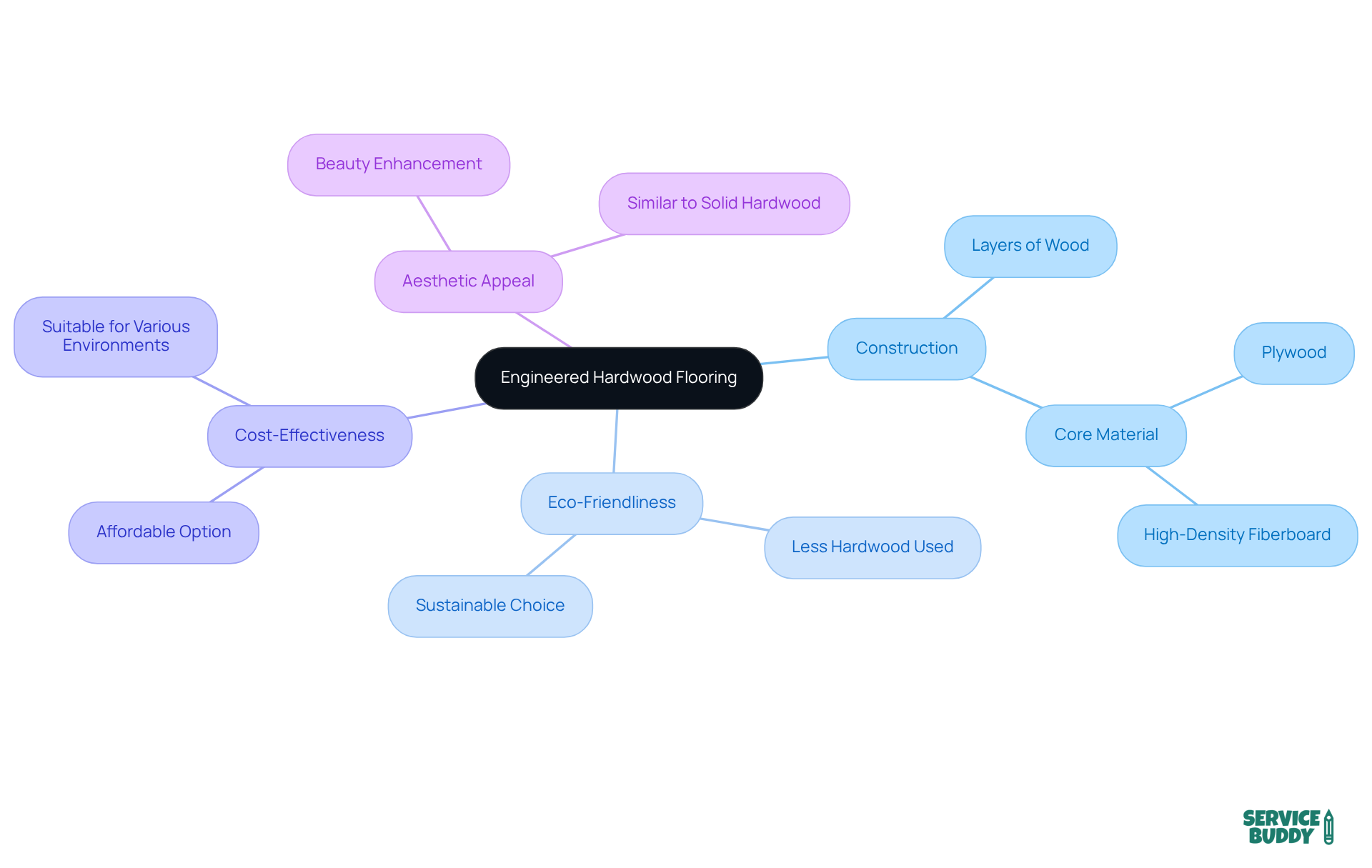
Eco-Friendly Vinyl Flooring: Modern and Durable Solution
Eco-friendly vinyl surfaces, which are a type of eco-friendly floor covering, are crafted from recycled materials and designed to be recyclable at the end of their life cycle. Modern manufacturing processes have significantly enhanced the sustainability of vinyl, effectively reducing its environmental impact. This choice of surface is available in a vast array of styles and designs, skillfully mimicking the appearance of natural materials like wood and stone.
Its durability and water resistance make it an ideal eco friendly floor covering for high-traffic areas, appealing to homeowners who prioritize both functionality and sustainability. Flooring business owners should consider these surfaces not only for their aesthetic appeal but also for the growing demand for eco friendly floor covering in the market.
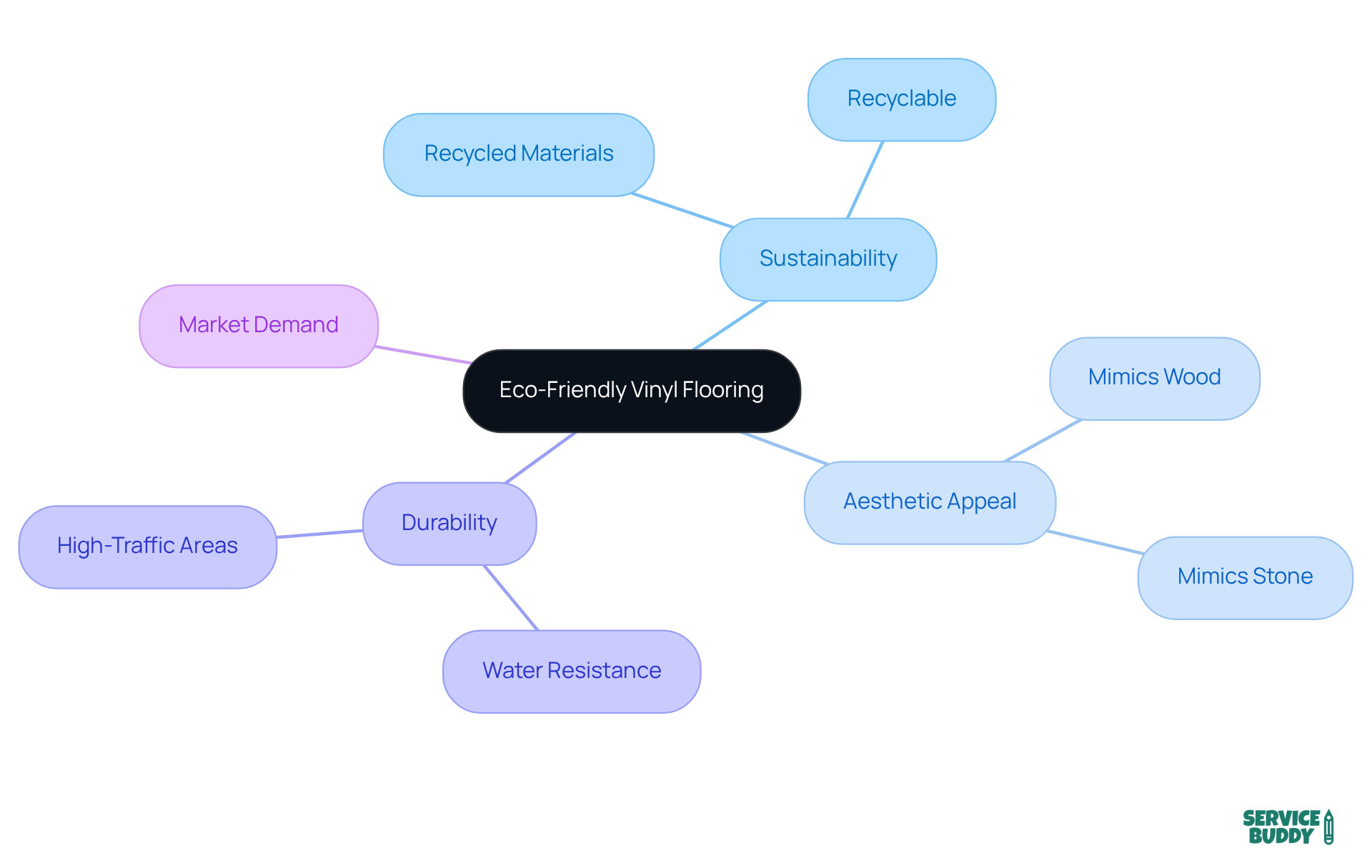
Wool Carpet: Durable and Biodegradable Flooring Option
Wool carpet, crafted from natural fibers, stands out as a biodegradable and renewable surface choice that resonates with eco-conscious values. Research indicates that wool carpets can endure for up to 25 years, significantly outlasting polymer alternatives, positioning them as a resilient option for businesses. Their inherent insulating properties not only contribute to energy efficiency but also help regulate indoor temperatures, enhancing comfort throughout the year.
Moreover, wool carpets are hypoallergenic and resistant to dust mites, which improves indoor air quality and fosters a healthier living environment. While initial shedding may occur, this typically diminishes over time, allowing the carpets to maintain their luxurious feel. Additionally, wool's natural flame resistance adds to its appeal as a safe flooring option.
This combination of luxury, resilience, and sustainability makes wool carpets an eco friendly floor covering that is preferred by consumers who prioritize both comfort and environmental responsibility. Flooring business owners can effectively market wool carpets by emphasizing these benefits, addressing any concerns regarding maintenance and initial shedding. By doing so, they not only meet consumer demand but also position themselves as leaders in eco friendly floor covering.

Conclusion
Exploring eco-friendly floor covering options reveals a transformative shift in the flooring industry, where sustainability meets style and functionality. The emphasis on selecting materials that not only enhance aesthetic appeal but also align with environmental values is paramount. By integrating eco-friendly solutions into flooring offerings, businesses can cater to the increasing demand from consumers who prioritize sustainability in their purchasing decisions.
Throughout this article, various flooring materials have been highlighted, showcasing their unique benefits. From the rapid growth and renewability of bamboo to the comfort and insulation provided by cork, each option presents distinct advantages. Reclaimed hardwood flooring emphasizes the importance of revitalizing existing materials, while linoleum, concrete, natural stone, engineered hardwood, eco-friendly vinyl, and wool carpet further expand the choices available for environmentally-conscious consumers. These materials not only fulfill aesthetic desires but also contribute to healthier indoor environments and reduced environmental impact.
In a world increasingly driven by sustainability, flooring businesses must seize the opportunity to lead in eco-friendly practices. By embracing these innovative materials and streamlining operations with platforms like Service Buddy, companies can enhance their offerings while aligning with consumer values. The commitment to eco-friendly floor coverings is not just a trend; it is a vital step towards a more sustainable future that benefits both businesses and the planet.
Frequently Asked Questions
What is Service Buddy and how does it benefit flooring companies?
Service Buddy is an all-in-one platform designed for flooring companies that streamlines quoting, job management, and client communication. It centralizes essential operations, allowing businesses to focus on eco-friendly materials and practices, thus boosting productivity and enhancing customer satisfaction and loyalty.
What features does Service Buddy offer to support eco-friendly initiatives?
Service Buddy includes a Growth Marketplace with tailored add-ons, such as marketing tools that promote eco-friendly floor covering and sustainable choices, helping businesses align with the growing demand for environmentally conscious products.
Why is bamboo flooring considered a sustainable option?
Bamboo flooring is highly sustainable due to its rapid growth rate, capable of growing up to three feet in just 24 hours. This makes it a renewable resource that reduces the need for deforestation. Additionally, bamboo has natural pest and moisture resistance, enhancing its durability.
What market share does bamboo hold in the eco-friendly flooring sector?
As of 2024, the natural surface market holds a 60% share in eco-friendly options, with the strand woven variety accounting for 55% of the market. This indicates a significant demand for bamboo as a sustainable flooring material.
What challenges do bamboo surfaces face?
Bamboo surfaces can be sensitive to moisture, which may limit their use in certain environments. Flooring business owners should consider this factor when exploring bamboo products.
What are the benefits of cork flooring?
Cork flooring is a renewable resource that provides comfort underfoot, excellent thermal and acoustic insulation, and natural resistance to mold and mildew. It is a healthy choice for indoor environments and enhances the aesthetic of any room.
How can flooring business owners leverage cork flooring?
By incorporating cork into their offerings, flooring business owners can meet the growing demand for eco-friendly solutions while addressing comfort and health concerns of clients, thereby differentiating their business in a competitive market.
List of Sources
- Bamboo Flooring: Sustainable and Fast-Growing Option
- expertmarketresearch.com (https://expertmarketresearch.com/reports/bamboo-flooring-market?srsltid=AfmBOooC45SsPOcCeX7XwL2KcH1OMb_zGDZ80wXWgAfS-Pf9odk9aN9o)
- deepmarketinsights.com (https://deepmarketinsights.com/report/bamboo-flooring-market-research-report)
- precedenceresearch.com (https://precedenceresearch.com/bamboo-flooring-market)
- techsciresearch.com (https://techsciresearch.com/news/24837-bamboo-flooring-market.html)
- market.us (https://market.us/report/bamboo-flooring-market)
- Reclaimed Hardwood Flooring: Eco-Friendly by Design
- archivemarketresearch.com (https://archivemarketresearch.com/reports/reclaimed-wood-flooring-671444)
- cognitivemarketresearch.com (https://cognitivemarketresearch.com/reclaimed-wood-flooring-market-report)
- vintagewoodfloors.com (https://vintagewoodfloors.com/blogs/vintageblogs/homeowner-what-are-the-benefits-of-using-reclaimed-wood-flooring-in-my-home?srsltid=AfmBOoq_GtNytZYhKSalytzi4qkDo90xEReI3ny8zQzCAhuE5E7HvjF5)
- marketreportanalytics.com (https://marketreportanalytics.com/reports/reclaimed-wood-flooring-184222)
- linkedin.com (https://linkedin.com/pulse/reclaimed-wood-flooring-market-industry-40-trends-6rqjc)
- Wool Carpet: Durable and Biodegradable Flooring Option
- ernestarugs.com (https://ernestarugs.com/blog/pros-and-cons-of-wool-rugs?srsltid=AfmBOoojyIdtkDU1mgXLo-QJsm8I6LG1wGb3MqoOp9bLyIMZ1TuybSZ1)
- brothers-floorcovering.com (https://brothers-floorcovering.com/blog/average-carpet-lifespan-how-long-should-your-carpet-last)
See Service Buddy in action with a live demo
Everything you need to run your flooring business, Service Buddy is your all-in-one management platform.

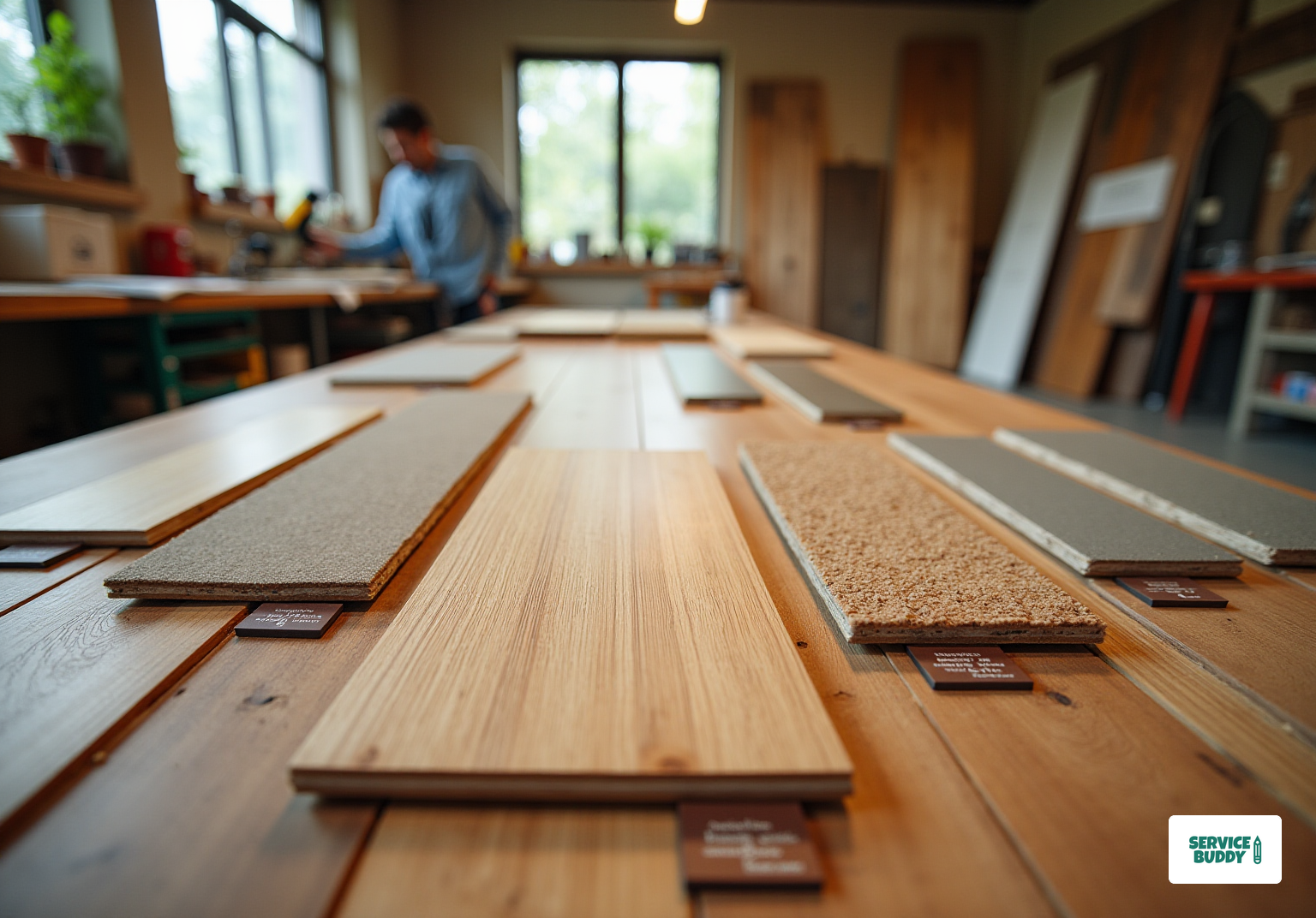


.svg)